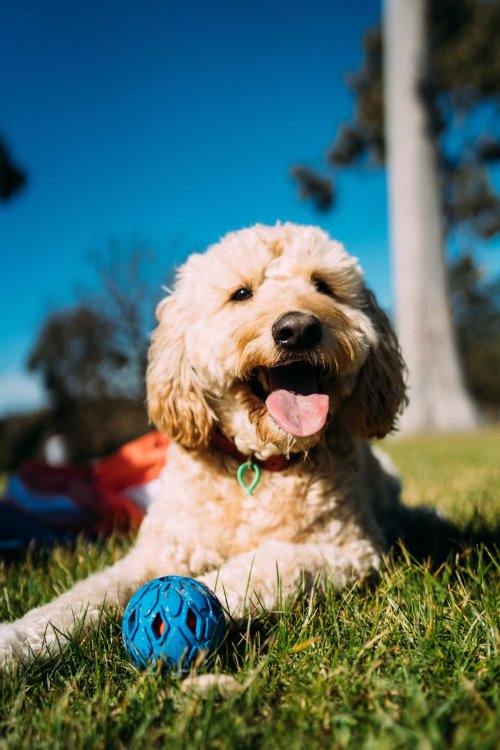An Authoritative Approach to Dog Training
Until recently, the general approach to dog training required force, dominance and a firm hand. With the evolution of science, the way we interact with dogs has changed. Contemporary trainers have often found themselves in ‘balanced’ (reward and punitive) or ‘positive’ camps. This article will look at an ‘Authoritative’ approach to dog training.
Traditional Dog Training
“Alpha Dog” Theory

Part of society still believes that pet dogs look for the dominant alpha in their pack because it's their innate instinct and that, consequently, dog owners must establish dominance over their pets if they want to be the leaders. Proponents of this dog training approach often claim that the hierarchy is best set by using force or punishing their dogs, thus guiding them towards desirable behaviour.
But simply put, they are wrong. Dr David Mech has focused his entire career on studying the pack theory by observing wild animals. This brought him the title of an expert on wolves' behaviour—that is, the ancestors of domestic dogs. His research led him to conclude that a typical wolf pack does not have alpha members but acts as a family, with the adults guiding the group activities in a division-of-labour system. But, relatedly, the dogs' instinct to seek the dominance of an alpha figure is baseless since even their wild ancestors don't show to have that instinct in the first place.
The Flaws of Alpha Approach
The alpha dog training style is authoritarian; this methodology enforces strict obedience through physical and psychological control with reduced concern for the dog's emotional well-being. A significant component of alpha dog training includes leash corrections, physical punishment, and force, which are frequently used to prevent or extinguish unwanted behaviours.
Although these methods may seem to solve unwanted behavioural problems speedily, the risk of psychological distress and neurological dysfunction is increased. Often dogs trained using the alpha methodology engage in behavioural suppression, which impairs their ability to regulate their emotions in a healthy manner. This impacts their nervous system, which, without healthy emotional or arousal regulation, will function in a prolonged state of stress which has adverse physical and emotional health consequences for the dog.
The alpha method is associated with using aversive tools, including e-collars and prong collars, of which there are many misleading and false claims. Our article on the mechanics of prong collars addresses some of these claims in a non-emotive manner. The inherent problem with aversive punishment is that although dogs eventually correct their behaviour, it is through fear of pain, not because they necessarily learned and understood the new behaviour pattern.
As the science of learning and behaviour continuously advances across various species, it has brought discoveries of much more efficient, humane, and fun techniques. From punishing dogs for mistakes, the focus has turned towards rewarding them for socially acceptable behaviours and encouraging them to think about and make good behavioural choices under various environmental circumstances. This approach uses positive reinforcement training methods, which many professional dog trainers advocate for.
Positive Reinforcement Dog Training

Positive reinforcement has proven to be a very effective way of training dogs, especially for teaching new behaviours. At Canine Body Balance, we readily use positive reinforcement in our canine conditioning programs, where we teach dogs new skills to improve their physical fitness or body condition.
In short, positive reinforcement means that the dog is rewarded in some way immediately after demonstrating the desirable behaviour. Since the dog enjoys the reward, they begin to repeat the desired behaviour and offer it more frequently in anticipation of gaining a reward.
An example of positive reinforcement is when you ask your dog to sit and immediately provide a reward when your dog performs the behaviour. Labels should only be added to behaviours once dogs understand what is expected of them; the process of developing this understanding is known as shaping, which provides positive reinforcement for approximations towards the behaviour until the dog understands the desired behaviour.
Long-term Benefits
In addition to a much more pleasant interaction between the owner and the dog, positive reinforcement training has been shown to change the dog's behaviour more effectively than the punishment approach.
An article published by the group of authors in the Frontiers in Veterinary Science Journal confirms that reward-focused training is far more effective than methods involving aversive stimuli such as electrical stimuli or lead pressure. The reason seems straightforward: just like people, dogs are much more inclined to learn if the process takes place in a positive environment that rewards accurate responses; their learning can be hampered by fear and stress.
Authoritative Dog Training: A Better Approach to Dog Training
What Does Authoritative Mean?

In 1966 Diana Baumrind, a developmental psychologist, stated that there are three main parenting styles: authoritarian (high control and low emotional warmth), authoritative (high control and high emotional warmth), and permissive (low control and high warmth). Over time, psychologists added another one: neglectful (low control and low warmth).
As human parenting literature suggests, authoritative parenting combines high demands and responsiveness. This child-centred parenting style guides the child toward socially acceptable behaviour while responding to the child's needs. The authoritative style in human parenting has proved to be the most effective style through numerous studies since then.
Results of the Authoritative Method
The research and literature on an authoritative approach has primarily focused on humans. However, it is an emerging area of interest in canine science that has shown promising results that mimic the findings in human psychology. This may not surprise many, since recent science published in Animal Cognition has shown that dogs' executive functions and cognition are remarkably similar to that of young children.
Recently, researchers from Oregon State University directly studied how pet parenting styles influence dog behaviour. They found that owners who were highly responsive to their dogs' emotional needs and held high expectations had dogs who were more resilient, emotionally secure, and better at problem-solving.
The authoritative approach is linked to secure attachment bonds in humans and dogs. It is proven to result in optimal child outcomes regarding high school/academic performance and high self-reliance/esteem levels. The research data shows that academic competence and self-reliance are significantly higher in authoritatively parented children. Furthermore, having one or two authoritative parents often protected against delinquency and depression in eighth-grade adolescents in the USA. Authoritative parenting promoted self-esteem, subjective well-being, secondary education results and continuing education in British fifteen-year-olds.
How is an Authoritative Style Applied to Dog Training?
Unlike the authoritarian style, an authoritative approach does not demand compliance through force; it also doesn't believe that the dog can do no wrong and thus allows unwanted behaviours to occur; this is more akin to a permissive approach. Indeed, the dog can engage in undesirable behaviours, regardless of the methodology used to train them. However, an authoritative system does require knowledge of age-related, developmentally normal behaviour and emotional and physical well-being.
Positive effects on behaviour and welfare can be achieved through authoritative parenting or handling in dogs, and Anna S. Olsson discusses this in the article "The Existence of Parenting Styles in the Owner-Dog Relationship". This shows us that the behaviour of dog handlers and that parents not only matter but plays a significant role in outcomes for both dogs and children.
Authoritative Style for Dog Parents
Ineke R. van Herwijnen, PhD, who specialises in behavioural ecology and animal welfare, divided the authoritative parenting style into two types that can apply to pet dog training techniques.
The authoritative-intrinsic value style (AUI) combines high responsiveness with a focus on the dog's specific needs and emotions, like allowing the dog to growl and express how it feels.
The authoritative-training style (AUT) combines high demandingness, high responsiveness and a focus on training pet dogs to behave appropriately through praise and a slow approach to learning new behaviours.
Steps to Learning New Behaviours With an Authoritative Dog Training Style
An authoritative training style requires several important things from the dog owner or trainer.
Rewards: The first is the use of the already mentioned positive reinforcement. Most often, this comes in the form of healthy (and tasty!) treats; however, some dogs respond better to patting, praise or short play as a reward. Spending time with your dog to discover what they find motivating is a big help when encouraging their progress in training. Positive behaviour reinforcement occurs when the rewards are delivered as soon as possible after the desired behaviour has been marked, typically done with an audible or visual signal from the handler.
Time: During training, give your dog enough time to understand what you are asking of it and connect the performed command with the following reward. Some dogs will take longer, while others will be quick in understanding. The ability to learn is directly affected by emotional state and level of arousal, so the ease of training will fluctuate, but it's the handler's responsibility to help guide the dog, being mindful that some days may take longer than others to work through a training task.
Health: The dog's physical and emotional well-being is considered in this approach. Hidden pain, for instance, can be a significant barrier to learning, and often it is an unwillingness to engage in training exercises that initiates a trip to the vet.
Environment: In addition to the demandingness of the task you put before your dog, consider the effects of environmental stimuli. When learning new behaviours, it is important to minimise environmental distractions; this allows the dog to focus more efficiently on the handler and the task at hand. As the dog progresses in their learning, the environment can be modified, challenging them to concentrate even in the presence of distractions.
Cues: Handler requests should be clear and consistent; this helps to ensure clarity. Short commands are what the dog will understand best, so speak less and be clear. If your dog needs help understanding what is being asked of them, help them without using force to complete the task. After, handlers may consider why the dog was unable to easily complete the task and make the necessary changes to help them be successful in their own decision-making process
Boundaries
For your dog to always be sure that it understands what you are asking, you must set clear and healthy boundaries. So, whenever your dog demonstrates the kind behaviour you want, hand out your reward. This will reinforce the association between good behaviour and pleasant consequence.
However, you must make sure not to reward bad behaviour unintentionally. For example, if your dog jumps on you when it wants to play, do not give in and show that you are reacting to that. Instead, wait for the dog to calm down—this will make the boundary of your attention clear.
Often unwanted behaviours can be stopped or prevented by a combination of controlling the dog's environment and training new behaviours to replace the old unwanted behaviour. Without healthy boundaries and using a permissive approach, dogs may inadvertently adopt socially unacceptable behaviours and continue to display those behaviours.
Having age, and individually appropriate high standards whilst ensuring our dogs do their best to meet them is a healthy form of boundary setting.
Dog’s Needs

Through training, we want to enable our dog to adapt as best as possible to function in the community. But dog owners should always remember that the dog has its own physical and emotional needs and that sometimes they will express them outside the framework we ask or what they have already learned.
If your dog is struggling to focus, having trouble with their learning, or behaving inappropriately, it's essential to consider whether their needs outside training are being met.
Dog’s Developmental Stage

When training, it's essential to keep in mind the developmental level of the dog you're working with. Every dog owner must consider that, for example, a puppy will follow commands and learn at a different pace than a two-year-old dog.
It is wise to start with professional dog training consultations that can offer advice on how to approach training as efficiently as possible. Even a few hours of professional training will help you gain more experience in approaching your dog's development and learning.
Extinguishing Unwanted Behaviours with an Authoritative Dog Training Style

The bottom line is—controlling unwanted behaviour means setting clear boundaries and sticking to them. To prevent undesirable behaviours, dogs are encouraged through positive reinforcement (rewards) to display wanted behaviour as often as possible, and handlers should be cognitively aware, and take action to reduce the effects of external and internal influences that may trigger undesired behaviours.
Unwanted behaviours are often associated with a higher state of arousal, the physiological response to high arousal makes it much more difficult for the dog to engage in behavioural inhibition and to focus, or listen to their handler. We wrote about Canine Arousal and the difficulties of optimal training during a dog's excessive responsiveness to environmental stimuli, such as passers-by, other animals or loud noises that disturb them (for example, a barking dog nearby). This condition is often linked to the dog's inability to regulate its emotional state, and as a result, the training results are reduced.
The first step to teaching your dog to regulate emotions and arousal levels can be done with Whole Energy Body Balance (WEBB) therapy. Designed to work on cognitive, neurological, muscular-skeletal and emotional systems, the WEBB acknowledges and responds to subtle communication signs. It helps animals feel validated and reduces the possibility of unwanted emotional escalation while making it easier for them to feel more secure during training. This emotional warmth, care and understanding is one of the underpinning factors of an authoritative approach to training dogs.





Karin
2023-10-08 05:53
Interesting approach.
I think, in the first sentence after the heading “How is an Authoritative Style Applied to Dog Training?” There is a confusing mistake. You wrote “Unlike the authoritarian style, an authoritative approach does demand compliance through force;” but shouldn’t it be doesn’t demand?